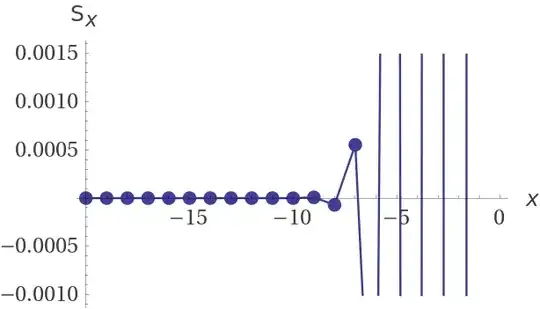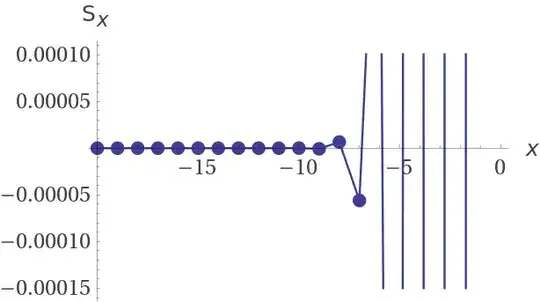Motivation:
It may be possible to find an integral representation using:
After seeing
with the use of gamma functions, I found that $$\mathrm{\int_0^\frac1e x^{-x} dx=\mathop \sum_{n≥1}\frac{Q(n,n)}{n^n}=\mathop \sum_{n≥0}\frac{E_{−n}(n+1)}{n!}=.48689…}$$ source 1 source 2
Here is a graph of the real side of the second to last series.
This result made me wonder how to evaluate the following. The definition of the exponential integral function still works as Re(n)<0:$$\mathrm {S\mathop=^{def}\sum_{n\in \Bbb Z^-} Γ(n,n)= \sum_{n=1}^\infty Γ(-n,-n) = \sum_{n=1}^\infty \frac{E_{n+1}(-n)}{(-n)^{n}}=\sum_{n=1}^\infty\int_{-n}^\infty \frac{dt}{t^{n+1}e^t}= \int_1^\infty\sum_{n=1}^\infty\frac{e^{nt}}{(-n)^nt^{n+1}}dt=\sum_{n=1}^\infty Q(n,n)Γ(n)=-0.5948551252563932027611440348… + 1.98586530379887152055255019996… i}$$
Here is an attempt at an integral representation. If only I could find a summation that I could evaluate because this “$n^n$” in the denominator makes it hard to find a closed form for the sum: $$\mathrm{S=\sum_{n=1}^\infty \int \frac d{dx} Γ(-n,-n\,x)\big|_0^1dx=\int_0^1\sum_{n=1}^\infty \frac{e^{nx}}{n^n x^{n+1}}dx\implies S=\sum_{n=1}^\infty \int_a^b \frac d{dx} Γ(-n,-n\,f(x)) dx =\int_a^b \sum_{n=1}^\infty -\frac{e^{n\,f(x)}f’(x)}{(-n\,f(x))^nf(x)}dx}$$
S converges because of this graph and is almost an alternating series with the absolute value of the summand decreasing to 0. Here are the partial sums for the negative bounds of summation:
Finally, here is the graph of the summand Γ(n,n) plotted at the index bounds:
A possible hint is understanding how to derive the $\int_0^\frac1e x^{-x}dx $ integral sum. You can “reverse” substitute and “reverse” integrate as I showed above.
The following uses an exponential integral function. Here is a result showing that you can easily find an alternate expression for “S” using @Steven Clark’s great answer in:
$$\mathrm{\int_1^\infty \frac{dx}{xe^x-1}=\sum_{n\ge1} E_{n}(n)=.269292…}$$
Here is a third example to support that this “S” constant should have another expression. This example uses the lower regularized incomplete gamma function:
$$\mathrm{\int_{-1}^0 e^{te^t}dt=1+\sum_{n=1}^\infty \frac{(-1)^nP(n+1,n)}{n^{n+1}}=.772158…}$$
Here is a possible form using the Abel-Plana formula. It may theoretically converge, but Wolfram Alpha has trouble finding it numerically. There are many possibilities for substitution, so I will leave it here:
$$\mathrm{\sum_{n=0}^\infty Γ(-n-1,-n-1)=\frac{Ei(1)-e+i\pi}{2}+\int_0^\infty Γ(-x-1,-x-1)+i\frac{Γ(-ix-1,-ix-1)-Γ(ix-1,ix-1)}{e^{2\pi x}-1}dx}$$
Here is theoretically working integral representation. We can integrate by each term:
$$\sum_1^\infty Γ(-n,-n)=\sum_{n=1}^\infty \frac{1}{2\pi i}\int_C\frac{Γ(x-n)Γ(x)}{Γ(x+1)(-n)^x}dx=\frac{1}{2\pi i}\int_{k-i\infty}^{k+i\infty}\frac{1}{ (-1)^{x}x}\sum_{n=1}^\infty \frac{Γ(x-n)}{n^x}dx,\text{max}(\text{Re}(n),0)<k$$
How can I find an alternate representation for “S”? You can find a better integral expression of “S”. If not, then please find a closed form, optional, or a series representation which converges faster. Please correct me and give me feedback!


